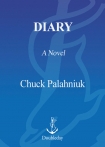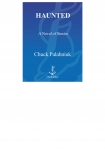Diary, Chuck Palahniuk [spicy books to read .TXT] 📗

- Author: Chuck Palahniuk
Book online «Diary, Chuck Palahniuk [spicy books to read .TXT] 📗». Author Chuck Palahniuk
Misty said, “Temporary. Transitory.” She paused and said, “Confusing.”
Her three words to describe a sealed white room.
In her previous life, still walking with Peter, not holding hands, he told her how Carl Jung's test worked. Each question was a conscious way to access the subconscious.
A color. An animal. A body of water. An all-white room.
Each of these, Peter said was an archetype according to Carl Jung. Each image represented some aspect of a person.
The color Misty had mentioned, gold, that's how she saw herself.
She'd described herself as “Shiny. Rich. Soft,” Peter said.
The animal was how we perceived other people.
She perceived people as “Dirty. Stupid. Ugly,” Peter said.
The body of water represented her sex life.
Busy, fast, and crowded. According to Carl Jung.
Everything we say shows our hand. Our diary.
Not looking at her, Peter said, “I wasn't thrilled to hear your answer.”
Peter's last question, about the all-white room, he says that room with no windows or doors, it represents death.
For her, death will be temporary, transitory, confusing.
August 12—
The Full Moon
THE JAINS WERE a sect of Buddhists who claimed they could fly. They could walk on water. They could understand all languages. It's said they could turn junk metal into gold. They could heal cripples and cure the blind.
Her eyes shut, Misty listens while the doctor tells her all this. She listens and paints. Before dawn, she gets up so Grace can tape her face. The tape comes off after sunset.
“Supposedly,” the doctor's voice says, “the Jains could raise the dead.”
They could do all this because they tortured themselves. They starved and lived without sex. This life of hardship and pain is what gave them their magic power.
“People call this idea ‘asceticism,' ” the doctor says.
Him talking, Misty just draws. Misty works while he holds the paint she needs, the brushes and pencils. When she's done he changes the page. He does what Tabbi used to.
The Jain Buddhists were famous throughout the kingdoms of the Middle East. In the courts of Syria and Egypt, Epirus and Macedonia, as early as four hundred years before the birth of Christ, they worked their miracles. These miracles inspired the Essene Jews and early Christians. They astonished Alexander the Great.
Doctor Touchet talking on and on, he says Christian martyrs were offshoots of the Jains. Every day, Saint Catherine of Siena would whip herself three times. The first whipping was for her own sins. Her second whipping was for the sins of the living. The third was for the sins of all dead people.
Saint Simeon was canonized after he stood on a pillar, exposed to the elements, until he rotted alive.
Misty says, “This is done.” And she waits for a new sheet of paper, a new canvas.
You can hear the doctor lift the new picture. He says, “Marvelous. Absolutely inspired,” his voice fading as he carries it across the room. There's a scratching sound as he pencils a number on the back. The ocean outside, the waves hiss and burst. He sets the picture beside the door, then his doctor's voice comes back, close and loud, and he says, “Do you want paper again or a canvas?”
It doesn't matter. “Canvas,” Misty says.
Misty hasn't seen one of her pictures since Tabbi died. She says, “Where do you take them?”
“Someplace safe,” he says.
Her period is almost a week late. From starvation. She doesn't need to pee on any pregnancy test sticks. Peter's done his job, getting her here.
And the doctor says, “You can start.” His hand closes around hers, and pulls it forward to touch the rough, tight cloth already prepped with a coat of rabbit-skin glue.
The Jewish Essenes, he says, were originally a band of Persian anchorites that worshiped the sun.
Anchorites. This is what they called the women sealed alive in the basements of cathedrals. Sealed in to give the building a soul. The crazy history of building contractors. Sealing whiskey and women and cats inside walls. Her husband included.
You.
Misty, trapped in her attic room, her heavy cast keeping her here. The door kept locked from the outside. The doctor always ready with a syringe of something if she gets uppity. Oh, Misty could write a book about anchorites.
The Essenes, Dr. Touchet says, lived away from the regular world. They trained themselves by enduring sickness and torture. They abandoned their families and property. They suffered in the belief that immortal souls from heaven were baited to come down and take a physical form in order to have sex, drink, take drugs, overeat.
Essenes taught the young Jesus Christ. They taught John the Baptist.
They called themselves healers and performed all of Christ's miracles—curing the sick, reviving the dead, casting out demons—for centuries before Lazarus. The Jains turned water into wine centuries before the Essenes, who did it centuries before Jesus.
“You can repeat the same miracles over and over as long as no one remembers the last time,” the doctor says. “You remember that.”
The same way Christ called himself a stone rejected by masons, the Jain hermits had called themselves logs rejected by all carpenters.
“Their idea,” the doctor says, “is that the visionary must live apart from the normal world, and reject pleasure and comfort and conformity in order to connect with the divine.”
Paulette brings lunch on a tray, but Misty doesn't want food. Behind her closed eyelids, she hears the doctor eating. The scrape of the knife and fork on the china plate. The ice rattling in the glass of water.
He says, “Paulette?” His voice full of food, he says, “Can you take those pictures there, by the door, and put them in the dining room with the others?”
Someplace safe.
You can smell ham and garlic. There's something chocolate, too, pudding or cake. You can hear the doctor chew, and the wet sound of each swallow.
“The interesting part,” the doctor says, “is when you look at pain as a spiritual tool.”
Pain and deprivation. The Buddhist monks sit on roofs, fasting and





Comments (0)